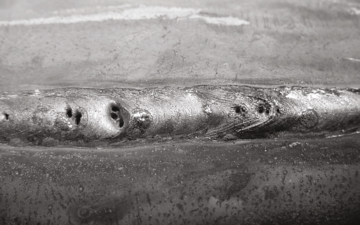What is Porosity in Welding: Secret Factors and Their Influence On Weld High Quality
What is Porosity in Welding: Secret Factors and Their Influence On Weld High Quality
Blog Article
Untangling the Enigma of Porosity in Welding: Tips for Reducing Defects and Taking Full Advantage Of Quality
In the intricate world of welding, porosity remains a relentless challenge that can significantly affect the top quality and honesty of welded joints. Comprehending the variables that add to porosity development is crucial in the search of remarkable welds. By unraveling the enigma of porosity and executing reliable techniques for flaw minimization, welders can raise the criteria of their job to attain exceptional quality end results. As we explore the depths of porosity in welding, uncovering the tricks to its avoidance and control will certainly be extremely important for professionals looking for to master the art of premium weldments.
Comprehending Porosity in Welding
Porosity in welding, a common problem come across by welders, refers to the existence of gas pockets or voids in the welded product, which can endanger the honesty and top quality of the weld. These gas pockets are commonly caught during the welding process due to various aspects such as improper protecting gas, contaminated base materials, or inaccurate welding specifications. The formation of porosity can deteriorate the weld, making it at risk to breaking and corrosion, inevitably resulting in structural failures.
Comprehending the source of porosity is crucial for welders to successfully avoid its incident. By acknowledging the significance of preserving correct gas shielding, making sure the sanitation of base materials, and enhancing welding settings, welders can significantly reduce the probability of porosity development. Furthermore, making use of strategies like pre-heating the base product, using appropriate welding strategies, and conducting complete assessments post-welding can even more aid in minimizing porosity flaws. On the whole, a thorough understanding of porosity in welding is crucial for welders to create top quality and durable welds.

Common Reasons For Porosity
When checking welding procedures for potential top quality concerns, understanding the common causes of porosity is important for keeping weld stability and preventing structural failures. Porosity, identified by the existence of cavities or spaces in the weld metal, can significantly endanger the mechanical homes of a welded joint.
Another prevalent source of porosity is the existence of dampness and contaminants externally of the base steel or filler material. When welding products are not properly cleaned or are exposed to high levels of moisture, the evaporation of these pollutants throughout welding can produce spaces within the weld grain. Furthermore, welding at improper specifications, such as exceedingly high travel rates or currents, can create excessive turbulence in the weld swimming pool, trapping gases and creating porosity. By dealing with these usual reasons through proper gas shielding, product preparation, and adherence to ideal welding specifications, welders can decrease porosity and boost the high quality of their welds.
Strategies for Porosity Prevention
Carrying out reliable preventive measures is important in reducing the incident of porosity in welding procedures. One method for porosity avoidance is ensuring correct cleaning of the base metal before welding. Pollutants such as oil, grease, rust, and paint can cause porosity, so comprehensive cleaning utilizing ideal solvents or mechanical methods is necessary.

Using top notch filler products and securing gases that are suitable for the imp source base steel and welding procedure can dramatically lower the danger of porosity. In addition, keeping proper welding criteria, such as voltage, present, travel speed, and gas circulation rate, is important for porosity avoidance.
In addition, employing proper see post welding methods, such as keeping a constant travel speed, electrode angle, and arc length, can aid avoid porosity (What is Porosity). Sufficient training of welders to ensure they adhere to finest techniques and high quality control treatments is also crucial in decreasing porosity issues in welding

Finest Practices for High Quality Welds
One secret method is keeping appropriate tidiness in the welding location. Extensively cleaning up the workpiece and bordering area prior to welding can aid alleviate these issues.
One more ideal method is to very carefully pick the suitable welding criteria for the particular materials being joined. Proper specification selection makes sure ideal weld penetration, combination, and overall top quality. Using high-quality welding consumables, such as electrodes and filler steels, can substantially influence the last weld quality.
Value of Porosity Control
Porosity control plays a crucial function in making sure the stability and high quality of welding joints. Porosity, identified by the visibility of cavities or voids within the weld steel, can considerably compromise the mechanical buildings and structural stability of the weld. Excessive porosity deteriorates the weld, making it extra prone to cracking, corrosion, and total failing under operational tons.
Efficient porosity control is necessary for keeping the desired mechanical homes, such as stamina, ductility, and toughness, of the welded joint. What is imp source Porosity. By minimizing porosity, welders can boost the total top quality and reliability of the weld, guaranteeing that it satisfies the performance requirements of the designated application
Moreover, porosity control is vital for accomplishing the preferred aesthetic appearance of the weld. Too much porosity not just weakens the weld however additionally diminishes its visual allure, which can be crucial in industries where aesthetics are necessary. Proper porosity control methods, such as using the right shielding gas, regulating the welding specifications, and making certain proper cleanliness of the base materials, are necessary for generating top notch welds with marginal issues.

Verdict
To conclude, porosity in welding is a common defect that can compromise the high quality of the weld. By comprehending the causes of porosity and executing correct prevention techniques, welders can minimize issues and attain better welds. It is necessary to manage porosity in welding to make sure the stability and toughness of the last item. Carrying out finest techniques for porosity control is crucial for achieving optimum welding results.
Report this page